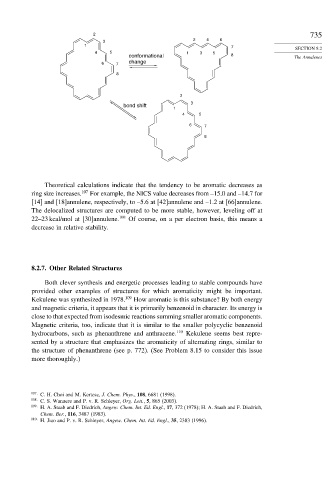Page 752 - Advanced Organic Chemistry Part A - Structure and Mechanisms, 5th ed (2007) - Carey _ Sundberg
P. 752
2 735
2 4 6
3
1 7
SECTION 8.2
4 5 1 3 5
conformational 8 The Annulenes
change
6 7
8
2
3
bond shift
1
4 5
6 7
8
Theoretical calculations indicate that the tendency to be aromatic decreases as
ring size increases. 107 For example, the NICS value decreases from –15.0 and –14.7 for
[14] and [18]annulene, respectively, to –5.6 at [42]annulene and –1.2 at [66]annulene.
The delocalized structures are computed to be more stable, however, leveling off at
22–23 kcal/mol at [30]annulene. 108 Of course, on a per electron basis, this means a
decrease in relative stability.
8.2.7. Other Related Structures
Both clever synthesis and energetic processes leading to stable compounds have
provided other examples of structures for which aromaticity might be important.
Kekulene was synthesized in 1978. 109 How aromatic is this substance? By both energy
and magnetic criteria, it appears that it is primarily benzenoid in character. Its energy is
close to that expected from isodesmic reactions summing smaller aromatic components.
Magnetic criteria, too, indicate that it is similar to the smaller polycyclic benzenoid
hydrocarbons, such as phenanthrene and anthracene. 110 Kekulene seems best repre-
sented by a structure that emphasizes the aromaticity of alternating rings, similar to
the structure of phenanthrene (see p. 772). (See Problem 8.15 to consider this issue
more thoroughly.)
107 C. H. Choi and M. Kertesz, J. Chem. Phys., 108, 6681 (1998).
108
C. S. Wannere and P. v. R. Schleyer, Org. Lett., 5, 865 (2003).
109 H. A. Staab and F. Diedrich, Angew. Chem. Int. Ed. Engl., 17, 372 (1978); H. A. Staab and F. Diedrich,
Chem. Ber., 116, 3487 (1983).
110
H. Jiao and P. v. R. Schleyer, Angew. Chem. Int. Ed. Engl., 35, 2383 (1996).

